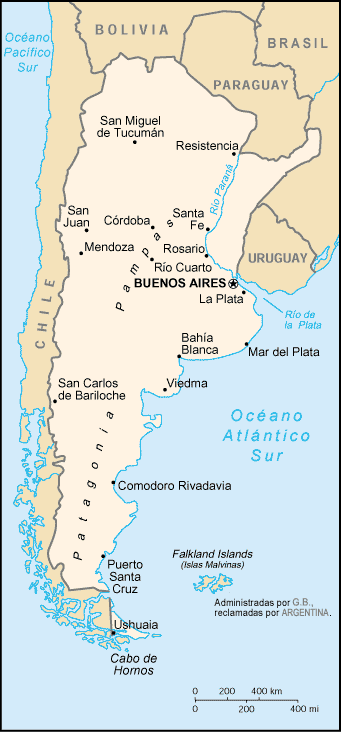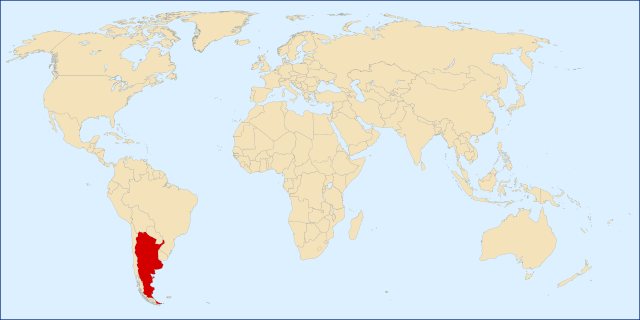La capital: Buenos Aires
La ubicación: Sudamérica
La moneda: el peso
Ciudades importantes: Córdoba, Rosario, La Plata
La economía: La agricultura, la ganadería, industria de procesamiento de alimentos, industria de electrónica y electrodomésticos.
El clima: cálido, templado y frío.

“Ar-map-es”, by Poroa, Wikimedia Commons is licensed under CC0 1.0
Interesting facts
Las Cataratas del Iguazú. Es considerado una de las 7 maravillas naturales del mundo. Son unas cataratas impresionantes que se encuentran entre Argentina, Brasil y Paraguay. Tiene 275 caídas de agua. Dos tercios de las cataratas están en el lado argentino. Muchos turistas llegan hasta el Parque Nacional Iguazú para apreciar estas maravillosas cataratas que tienen hasta 85 metros de altura. En el parque también puedes ver mucha vegetación tropical y animales muy exóticos.
La Patagonia. Es un área localizada en Sudamérica muy cerca al Polo Sur. El clima en esta zona es muy frío. Esta zona pertenece a Argentina y a Chile. La Cordillera de los Andes divide la Patagonia de Argentina y la de Chile. Esta zona es muy hermosa por sus altas montañas, ríos y lagos. El Glaciar Perito Moreno. Es un impresionante glaciar que se encuentra en el Parque Nacional Los Glaciares en la región de la Patagonia. Muchos turistas llegan hasta aquí para apreciar esta maravilla de la naturaleza.
El Aconcagua. Esta montaña es la más alta del continente americano y del hemisferio occidental. forma parte de la cordillera de los Andes. La montaña mide 2,837 ft. de altura. Gente de todas partes del mundo llegan hasta la cordillera de los Andes en Argentina para subir el Aconcagua. La altura y el frío son dos grandes desafíos para escalar esta montaña tan alta.
El tango. El tango es una danza muy romántica y apasionada que nació en Argentina. Este baile no fue muy popular entre las altas clases sociales su inicio por ser considerada vulgar, pero al ver que muchas personas en muchos otros países lo bailaban, los argentinos empezaron a practicarlo en todos los niveles sociales hasta hoy en día. Este baile ahora es emblemático de Argentina. Las parejas bailan muy unidas y sincronizadamente. El hombre dirige los movimientos y la mujer sigue al hombre en cada movimiento muy de cerca.
El mate. Es una bebida hecha de la infusión de hojas de yerba mate. El mate contiene cafeína y es la bebida nacional de Argentina. El Mate no es sólo popular en Argentina, sino que otros países sudamericanos como Uruguay y Paraguay también la beben. Muchos amigos y familiares se reúnen para conversar y tomar la bebida juntos. El mate se toma de unos recipientes de calabaza (calabash gourd) y una bombilla (metal straw) de metal. Esta costumbre es muy antigua, proviene de los indígenas Guaraná que son los habitantes precolombinos de esta zona.




